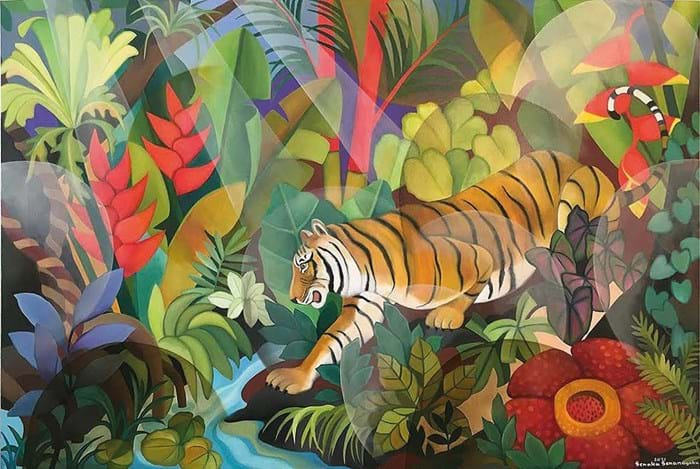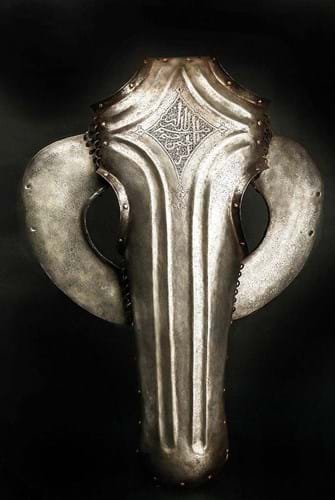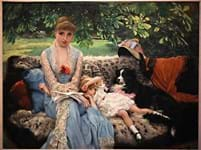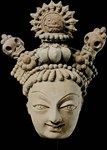DEALERS
PETER FINER
A 19th century Indian shamshir sword
This Indian sword, or shamshir, dates from the early 19th century and is available at Peter Finer, having been in private collections in Denmark and the UK. Its remarkably decorated hilt has three makaras –mythological sea-creatures that can be composed of elements of the crocodile, elephant, boar, fish, and peacock, which appear frequently in Hindu and Buddhist temple iconography as vahana, or vehicles on which the goddesses of the Ganges and Narmada rivers, and the sea god Varuna, ride.
The hilt is cast in silver and overlaid in gold.The eyes of each of the five animals on it are inset with rubies, as are the ears of the smaller makaras and lions. The makaras each have a blood-red glass tongue that is hinged to move up and down between sharp gold teeth.
The blade of the 3ft 5in (1.04cm) long sword is of steel watered in the distinctive ‘forty step’ or kirk narduban pattern; it has two cartouches inlaid with nasta’liq inscriptions in gold, the first translating as ‘made by Asad Allah’, the second ‘Abbas, slave of the king of holiness’.
The maker’s inscription refers to the most famous Persian swordsmith of the 17th century, ‘Asad Allah of Isfahan, after whom many Persian blades were inscribed to suggest that their quality was equivalent to that of the master’s blades. A comparable but later makara hilt in blued steel is in the armoury of the Rathores at Jodhpur. It has a similar blade with the same inscription.
MARCEL NIES ORIENTAL ART
An 11th century bronze Parvati
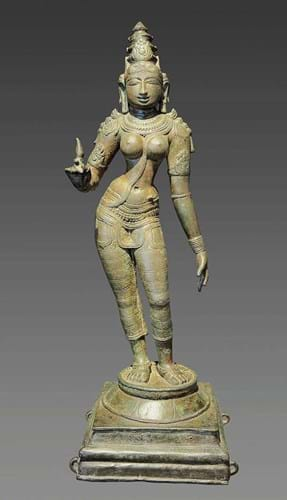
A bronze depicting Parvati thought to date from the early 11th century, offered at Marcel Nies Oriental Art.
Marcel Nies Oriental Art in Antwerp, Belgium, is exhibiting this bronze depicting Parvati who was the consort of Shiva and is considered the principal female deity in Hinduism.
This 2ft 1in (63cm) high sculpture shows her holding a blue lily (nilotpala) in her right hand with fine detail. Parvati’s posture is dynamic from all angles, her left arm is semi-flexed with her hand pointing down – a pose referred to as lolahasta in Sanskrit. The stylistic characteristics lead to an attribution to the Chola school, from the early 11th century.
The artist used the lost wax method and cast the figure solidly in one piece.
Parvati stands on a separately cast lotus pedestal on a square base. The four rings attached to the base were used for metal rods and indicate that the sculpture was carried in procession. The devotional use of the temple sculpture and ritual washings has created an attractive natural patina.
The sculpture has been in the Jerry Rodolitz collection in Thailand and the US and in the Laurent Solomon collection in Singapore.
It is on view at 27 Dover Street in London’s Mayfair district from October 28 to November 6.
GROSVENOR GALLERY
A large contemporary oil on canvas
Grosvenor Gallery is offering Tiger by Sri Lankan Senaka Senanayake (b.1951).
The 4 x 6ft (1.23 x 1.83m) oil on canvas was painted in 2021 and is among the artist’s works that draw attention to the depletion of his country’s rainforests not by showing destruction but by celebrating the positive. The depth of colours of the flora – a composite rather than all local – is achieved through layer on layer of paint applied over two to three weeks.
For more on this artist see our separate preview.
AUCTION HOUSES
CHRISTIE’S
Six portraits of Ottoman Sultans, Venetian School c.1600.

Six portraits of Ottoman Sultans, Venetian School c.1600, estimated at £800,000-1.2m at Christie’s. The subjects are, from top left to right, Sultan Orhan, Sultan Bayezid I, Isa Celebi, Sultan Mehmed I, Sultan Selim I and Sultan Selim II.
Christie’s Art of the Islamic & Indian Worlds sale on October 28 will offer this series of six portraits of Ottoman sultans dating from c.1600.
Derived from an original set of 14 produced in Venice at the instigation of the Grand Vizier Sokollu Mehmed Pasha (1506-79) in 1579, the subjects cover 250 years of the House of Osman, from Sultan Orhan (1281-1362) until Selim II (1524-74). One full set is the property of the Wittelsbach family and is currently on exhibition in Würzburg. Other sets are in the Topkapi Palace Museum in Istanbul.
The original Venetian set portraying the House of Osman is thought to have been created under the guidance of the Renaissance artist Paolo Veronese who served as the Serenissima’s official painter. These portraits are probably close copies as they exemplify some principal characteristics of Veronese’s style: the three-quarter bust format, the treatment of the textiles and the characterisation of the subjects that distinguish these paintings from other Ottoman imperial portraits.
The set, with an estimate of £800,000-1.2m, can be traced back to the collection of Count Gustav Adelmann von Adelmannsfelden (1858-1938), and was kept in castle Berg in Bavaria, until 1935.
SOTHEBY’S
A pair of Mughal spectacles set with emerald lenses in diamond-mounted frames
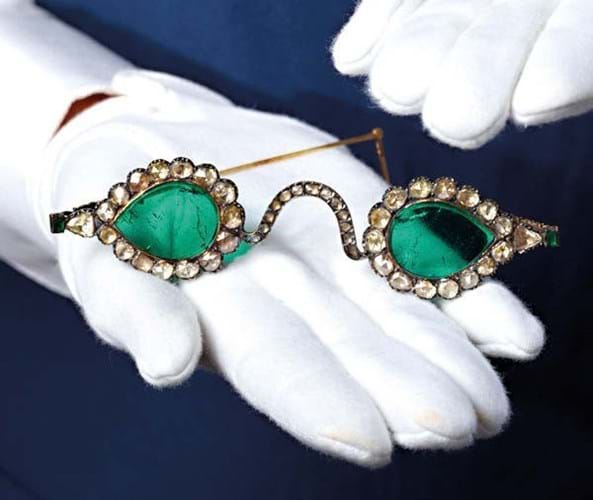
A pair of Mughal spectacles set with emerald lenses in diamond-mounted frames, estimated at £1.5m-2.5m at Sotheby’s.
After touring New York and Hong Kong, two extraordinary pairs of Mughal jewelled spectacles come for sale at Sotheby’s Arts of the Islamic World & India sale on October 27. The previously unrecorded spectacles carry hopes of £1.5m-2.5m each from ’an unknown princely treasury’ where they have been since the 1970s.
“These extraordinary curiosities bring together myriad threads – from the technical mastery of the gem cutter and the genius of craftsmanship to the vision of a patron who chose to fashion two pairs of eyeglasses quite unlike anything ever seen before,” says Edward Gibbs, chairman of Sotheby’s Middle East & India.
“They are undoubtedly a marvel for gemologists and historians alike, and it is a real thrill to be able to bring these treasures to light and to offer the world the opportunity to wonder at their brilliance and the mystery behind their creation.”
The lenses in the spectacles date from the 17th century when, for a spectacularly wealthy patron, they were cut from a flawless Golconda diamond, weighing over 200 carats (the Halo of Light) and an emerald weighing at least 300 carats (the Gate of Paradise). These filters were deemed aids for spiritual enlightenment – with diamonds thought to illuminate and emeralds believed to have held miraculous powers to heal and to ward off evil.
Around 1890 the lenses were placed in new frames, decorated with rosecut diamonds. The spectacles with emerald lenses, shown here, are the ones selected for the award shortlist.
CHISWICK AUCTIONS
A 16th century engraved steel shaffron
This engraved steel shaffron – a horse’s head defence – comes from 16th century Ottoman Turkey or Anatolia.
It was formed from a single piece of steel and comes with flat plain cheek plates attached to its sides with short chain mail links.The cartouche at the top is incised with the basmala bi-smi llāhi r-ramāni r-raīmi (In the name of God, the Most Gracious, the Most Merciful), a phrase used mostly when starting good deeds. The inscription is arranged on four overlapping horizontal levels and set against scrolling vegetal spirals reminiscent of the decoration of early 16th-century Iznik wares.
The item is accompanied by an invoice from 1980 attesting that the shaffron was once part of the Wladimir Rosenbaum collection of antiquities, which he sold at his gallery in Ascona, Galleria Serodine. From 1980-94 it was in a private collection in Belgium and since then it has been in another private collection in Germany.
Similar shaffrons can be found in other collections including at the Metropolitan Museum of Art, New York.
The shortlisted example here is estimated at £4000-6000 in the Islamic & Indian Art sale at Chiswick Auctions on October 29.


